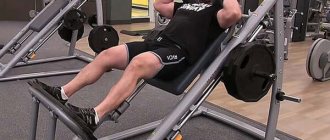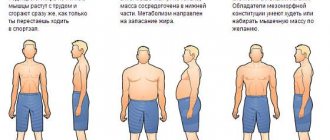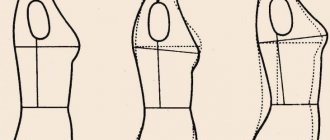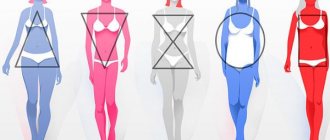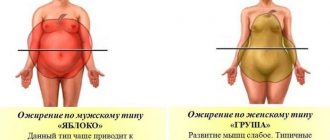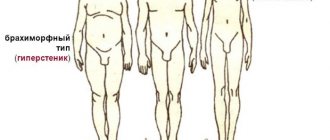Types of constitution
Some scientists identify three different types of human body build: ectomorph, mesomorph, endomorph, as well as some signs of how to determine which group you belong to. People, depending on their figure, will also be called: asthenic, normosthenic, hypersthenic.
Ectomorphic or asthenic
According to beliefs, this type represents a typical thin person. Asthenics have narrow shoulders, thin wrists, a sharp intercostal angle, a relatively low diaphragm, an elongated chest from top to bottom (and a relatively reduced circumference), an elongated neck, and narrow shoulders.
We also learned from the Internet: “The ectomorph has small joints and almost no muscles.” Hmm, how's that? What is he, a humanoid? Probably, the authors meant that an asthenic person’s muscles do not grow well and it is difficult for him to gain weight.
How to determine?
- Small body
Flat chest
- Narrow shoulders
- Skinny
- Lack of muscles
- Difficulty gaining muscle mass
- Fast Metabolism
Endomorphic or hypersthenic
These are people with a decent amount of fat mass and have broad shoulders, large body circumferences in different places, including on the limbs, and an obtuse intercostal angle. It's not worth it to gain a lot of work for them! Hypersthenics are not deprived of muscle mass, especially their upper leg muscles are well developed.
Features:
- Round body
Rapidly increase both muscle and fat mass
- Most often short in stature
- It's quite difficult to lose weight
- Slow Metabolism
Mesomorphic or normosthenic
This type is characterized by good development of muscle mass, and as a result, a strong and developed bone skeleton. The amount of adipose tissue is approximately average. Features of the internal structure - the chest is convex, the shoulders are wide, the length of the limbs is proportional. All characteristics correspond to average.
It is quite difficult for an asthenic person to build muscle mass. He has an excellent metabolism that burns calories quickly. An ectomorph needs to eat extremely actively, both to gain weight and to maintain it. But he doesn’t need to lose weight.
An ectomorph has no difficulty losing excess weight, so subsequently his muscles are dry and not covered with fat layers.
Training program for an ectomorph: strength training should be intense, but short-lived (45-60 minutes), focus on the base ( basic exercises ). Cardio for no more than 10 minutes as a warm-up/cool-down .
Nutrition for an ectomorph to gain muscle mass: increase the amount of calories in general and carbon in particular. In all KBJU calculations, adhere to their upper limit. Sports supplements are recommended for use .
What does the asthenic type look like in women:
Hypersthenics gain weight quite easily, but the problem is that most of this mass is not muscle. Endomorphs are obsessed with one question: “how to lose weight”? Usually they do not need sports supplements so much, of course, provided that their diet contains a sufficient amount of protein.
Training program for endomorphs for weight loss: it is best to train using a three-day split program . The program is based on heavy basic exercises that help burn a large number of calories and gain muscle mass. The duration of the workout should be 90-120 minutes, starting with a good warm-up and ending with at least 30 minutes of intense cardio.
Dear ladies! If you have problems with blood vessels, then DO NOT do , this is fraught with capillary mesh or even varicose veins . Move it to the next day or better yet, don’t do it at all. Losing weight will take longer, but you will have healthy, beautiful legs
Mesomorphs are born with the body of an athlete. This type quickly builds muscle mass and loses excess weight. They are naturally strong, which is an excellent platform for further growth.
Distinctive features of a mesomorph:
- Athletic build
- Rectangular body shape
- Force
- Build muscle mass quickly
- More susceptible to excess weight than ectomorphs
Mesomorphs (also people with an asthenic body type) quickly build muscle mass, especially beginners. On the other hand, mesomorphs can also quickly gain excess weight. This means they must watch the number of calories they consume. For mesomorphs, the ideal option is a combination of strength training and cardio.
Mesomorph women have initial genetic bonuses: it is easy for them to stay thin and fit, but they, as a rule, lack motivation for weight loss, and if you start eating and don’t exercise, the body can quickly “swim”, especially in the abdomen and waist (remember , yes, fat by gender ?)
Training program for mesomorphs: focus on the base and working individual muscle groups with isolated exercises. Remember variety: change the number of approaches and repetitions, work time and rest time, working weight, combinations of exercises, amplitude .
The program should be cyclical: 3-4 weeks of high-intensity training, then 1-2 weeks of training at lower speeds, this will give a greater effect and help avoid overtraining.
Am I sometimes a mesomorph?
To determine your own somatotype, you need to skillfully operate with the following characteristics:
| Characteristic | Meaning | Explanation |
| Weight gain rate | High | Mesomorphs quickly gain total mass. All this is connected with the processes of evolution. Such people are typical “hunters” who, on the one hand, must be strong enough to kill a mammoth, and on the other, must be able to go for weeks without food. |
| Net weight gain rate | Low | Despite a genetic predisposition to weight gain, mesomorphs slowly gain muscle mass. This is due to the fact that with muscle growth, energy carriers (fat cells) also increase; this is the only way the body will be calm and able to fully provide muscle tissue with energy. |
| Wrist thickness | Fat | Due to the increased muscle corset, the thickness of all bones also differs in order to provide sufficient attachment to the muscle lever. |
| Metabolic rate | Moderately slow | Despite their impressive strength, mesomorphs are not particularly durable. This is due to the fact that their rate of calorie consumption and expenditure is slower compared to ectomorphs. Thanks to this, the body can create acceleration at the moment of peak load. |
| How often do you feel hungry? | Often | Mesomophras are carriers of the largest basic muscle corset with increased energy consumption. In order not to trigger catabolic processes, the body strives to constantly replenish energy from external sources. |
| Ratio of weight gain to calories consumed | High | Due to slow metabolism, almost all excess calories in the blood are immediately stored in glycogen or in the fat layer. |
| Basic strength indicators | Above average | More muscle means more strength. |
| Subcutaneous fat percentage | <25% | Despite a genetic predisposition to weight gain, mesomorphs slowly gain muscle mass. With muscle growth, energy carriers (fat cells) also increase. |
No matter how close you come to the data from the table, remember that a pure somatotype does not exist in nature. We are all a combination of different subtypes of somatotypes, of which there are actually more than several hundred. This means that you shouldn’t classify yourself as one species and complain about it (or, on the contrary, rejoice). It is better to study your own body in more detail in order to skillfully use your advantages and neutralize your disadvantages.
How to find out yours?
According to the Internet, one of the main differences between these three types is the different skeletal structure. The mesomorphic type has wide, thick bones, the ectomorphic type has thin bones, and the endomorphic type occupies an intermediate position. The bones determine the height (there's no arguing that) and the width of your figure. Modern technologies are not yet able to change these parameters. You cannot become taller or shorter, nor can you make your hip bones or shoulder bones narrow.
How to determine what type of build you have - by your wrist. To understand this, it is enough to take a few measurements. The easiest way to determine the type of constitution is by the wrist. Measure its circumference with a measuring tape:
• asthenic - up to 17.5 cm in men, up to 15 cm in women; • normosthenic - 17.5-20 cm in men, 15-17 cm in women; • hypersthenic - above 20 cm in men, more than 17 cm in women.
As we can see, methods for assessing a person’s body type, to put it mildly, look unscientific and forced! The boundaries are very close, so the difference is practically erased and determining the body type becomes like a lottery.
Are you sure that you are a mesomorph and not an overfed ectomorph? And are you really an endomorph or just a mesomorph who overdoes it with food? Unanswered questions. These divisions are ephemeral and made “by eye”, according to external (the most unreliable) signs, although the skeletal structure of people may indeed differ.
Advantages
Returning to the physique features of a mesomorph, we can highlight the main advantages that affect the training cycle:
- Force sensitivity.
- High recovery rate. Mesomorph is the only somatotype that can afford to train more than 3 times a week without taking additional AAS.
- Stable weight gain. This does not mean that a mesomorph is stronger than an ectomorph, since in most cases, the weight/strength ratio does not change.
- Metabolism that can be finely tuned.
- Less traumatic. This is facilitated by the thickness of the bones.
- High strength indicators - but this is facilitated by lower weight. Since the level of leverage is lower, a person needs to lift the barbell a shorter distance, which allows him to lift more weight.
Why is this all nonsense?
In theory, those with the third type are most inclined to be overweight, have a stocky figure type, they will never be weightless princesses, however, for some reason, in life there is often evidence to the contrary. Your body type doesn't matter at all!
There is such an anecdote: “A woman comes to see a doctor, tries to clasp her left wrist with her right hand and says: “Doctor, you can see for yourself that I weigh so much because I have a wide bone.” The doctor looks at her wrist and answers with a smile: “My dear, a brontosaurus has a wide bone, but you are simply obese .
William Sheldon is a scientist who studied the human body, trying to find any patterns and who identified these types of structure. He was a psychologist . Faith, of course, is not enough for him. With the same success, one could have identified not 3, but 5 categories, or 7, or used some other criteria for categorization.
The more classification parameters, the easier it is to describe everything in the world. The question is what model is behind these parameters! And why bother adjusting all this? Reminds me of zoology. If this classification allowed us to make predictions (give tailored recommendations), then this would make sense. And here, even without abstruse speeches, everything is clear: eat less - you will lose weight, eat more - you will gain weight.
Everything is already in the lexicon: fat, thin and neither here nor there, in our opinion an excellent classification



